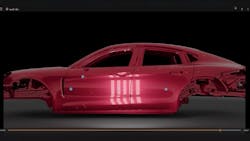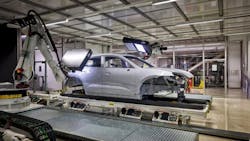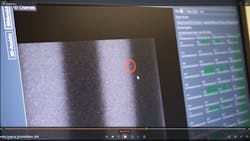Porsche Adds AI-Enabled Robotic Paint Inspection System
The name Porsche is synonymous with the vision of a high-end luxury vehicle. Consumers expect every feature of the automobile to be flawless, including the exterior paint.
That is why the 94-year-old company (Stuttgart, Germany) recently automated the paint inspection process at its plant in Leipzig, Germany, using 3D imaging and AI-enabled algorithms.
Porsche produces cars with three different drivetrains—combustion, hybrid, and electric—on a single production line at the plant. Opened in 2002, the plant strives for what Porsche refers to as “efficient, resource-sparing processes,” and automation is an enabler of achieving that goal.
Combining 3D Imaging and Machine Learning
Using 3D imaging and machine learning to improve outcomes in the paint shop is one example of this approach. “The automatic defect detection system helps our employees detect even the smallest irregularities on the paint surface. This objective assessment improves efficiency, reduces ergonomic strain, and enables cost-effective work processes,” explains Henning Steinborn, head of the paint shop at Porsche Leipzig.
Related: 5 Ways Cobots Are Boosting the Efficency of Automotive Manufacturing Processes
A robotic-based system applies paint to vehicles. Before the automated inspection process was launched in 2023, however, Porsche relied on its employees to identify flaws in the painted surface by sight and touch. They worked at nine stations in two clearcoat inspection tunnels. This was a time-consuming and physically exhausting process that relied on the subjective assessment of employees, Steinborn explains.
WIth the new automated process, Porsche detects, classifies, and visualizes defects on the entire exterior of every series-production car produced at the plant.
Components of the Machine Vision System
This is how it works: Two robot arms capable of handling up to 125 kg—one on each side of the production station—are installed on mobile platforms. The robots wield the machine vision system, which is installed inside a large rectangular enclosure. The system scans the entire surface of a car’s exterior. The process creates approximately 100,000 images, or one image for every 2.5 millimeters of the car’s surface.
Each scanner, housed inside the enclosure, includes an LED light panel, four security cameras with LEDs, four high-speed grayscale cameras, and five embedded computers. The system projects different patterns of light on the surface of the car, and the reflections are captured in the images.
AI-Enabled Image Processing
A deep learning module identifies and classifies irregularities in the paint by analyzing distortions in the patterns of light reflected on a car’s surface. "The light patterns make the tiny irregularities easier to detect,” Steinborn explains.
Related: AI Vehicle Inspection with Ultra-High-Resolution Cameras
The deep learning algorithm was trained on sample images and compares new images against them to identify defects such as pinholes, craters, and particles of dust or other debris.
3D Visualization Helps Employees
The machine vision software sends a dataset with the details on defects per car to a database. Then a 3D visualization program, loaded on a different computer, highlights the defects in a 3D model of the car. The 3D model is displayed on a computer monitor in the finishing tunnel. Using this information, employees make necessary corrections to a car’s body manually. They also have access to high-resolution close-up images and other details about each defect.
Citing company policies, Steinborn declined to provide details on the suppliers of components, software, and systems used in the automated process. However, a public video on the company’s website appears to show a system from ISRA Vision AG (Darmstadt, Germany), which markets an automobile paint inspection system. Robots from KUKA AG (Augsburg, Germany) are also visible in the video.
The finishing line is the last process within the paint shop. If no defects remain after they are reworked and checked, the vehicles proceed to assembly and final build, Steinborn explains.
Related: German Company Develops AI-Enabled Tire Inspection System
Data on each paint defect is automatically stored for traceability. Porsche uses statistical analysis and comparison with historical data to determine trends in defect type or location, potentially leading to future improvements in the overall automated painting process.
About the Author
Linda Wilson
Editor in Chief
Linda Wilson joined the team at Vision Systems Design in 2022. She has more than 25 years of experience in B2B publishing and has written for numerous publications, including Modern Healthcare, InformationWeek, Computerworld, Health Data Management, and many others. Before joining VSD, she was the senior editor at Medical Laboratory Observer, a sister publication to VSD.



